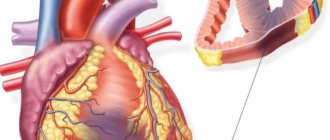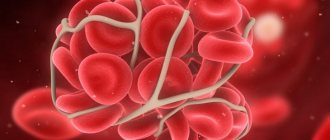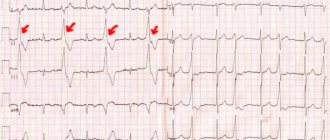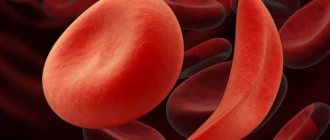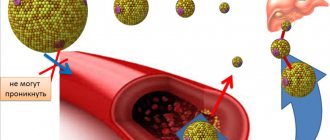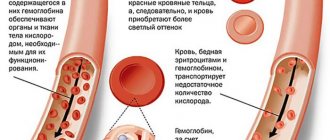Cardiomyopathy is a pathology of the heart muscle, which has various causes.
The disease can develop as a result of genetic disorders, hormonal changes, the toxic effects of drugs, alcohol, and other pathological conditions.
Cardiomyopathy as a separate nosology has a general code according to ICD 10, indicated by column I42.
Types and manifestations
The classification of myocardial changes is based on the identification of pathogenetic mechanisms of the formation of cardiac disorders.
There are familial cardiomyopathies, the cause of which lies in hereditary factors. Hypertrophy with subsequent wear and tear of the heart muscle in athletes is not uncommon.
Contrary to the often asymptomatic course of the disease, cardiopathy can cause sudden death in the “full health” of a person.
Typically, the pathology is diagnosed when patients present with characteristic cardiac complaints of palpitations, chest pain, general deterioration, weakness, dizziness, and fainting.
Forecast
In severe forms of endocrine cardiomyopathy, the prognosis is unfavorable for 70% of patients. The cause of death is progression of the disease. The prognosis remains favorable for patients in whom DMCM was identified at an early stage.
An accurate prognosis is possible only after examining the left ventricle. A lethal outcome is most likely when it is hypertrophied and greatly expanded.
The following video contains many useful tips for parents whose children have cardiomyopathy:
What changes are happening
There are several response processes on the part of the myocardium when exposed to a damaging etiological factor:
- the heart muscle may hypertrophy;
- the cavities of the ventricles and atria are overstretched and expanded;
- directly as a result of inflammation, myocardial restructuring occurs.
Morphologically altered heart tissue is not able to adequately provide blood circulation. Heart failure and/or arrhythmia come to the fore.
Causes
The disease usually occurs due to functional disorders in the human endocrine system. Disturbances in cardiac muscle metabolism lead to undesirable changes and disturbances in the electrophysiological and mechanical functions of the heart. If you do not undergo the necessary treatment, the appearance of metabolic disorders and the onset of dyshormonal myocardial dystrophy cannot be ruled out. In the vast majority of its manifestations, it is of a reversible nature. In addition, such a disease can appear in the body when the thyroid gland stops functioning normally - as a manifestation of its concomitant disease.
Diagnosis and treatment
Cardiomyopathy is diagnosed based on the patient's medical history with additional studies.
Some of the screening methods are ECG (with 24-hour monitoring if necessary) and echocardiography (via ultrasound). To determine the cause of the disease, laboratory parameters of blood and urine are studied. Cardiopathy therapy consists of symptomatic treatment of the main manifestations. For this purpose, tablet forms of antiarrhythmics, diuretics, and cardiac glycosides are prescribed. To improve myocardial nutrition, vitamins, antioxidants, and metabolic agents are prescribed.
To ease the work of the heart, drugs that reduce vascular resistance (calcium antagonists and beta blockers) are used.
If necessary, surgical intervention is performed to install a pacemaker.
Code in the list of diseases
Among diseases of the circulatory system (Article IX, I00-I99), the ICD diagnosis of “Cardiomyopathy” is allocated to a separate subsection of other heart diseases along with major nosological groups.
The division into cardiopathy depending on the manifestations and etiology is reflected in the international list of diseases with a dot after the main code.
Thus, cardiomyopathy, which developed on the basis of long-term use of medications, is coded according to ICD 10 as I42.7.
Myocardial pathology is often detected as part of a symptom complex of various diseases.
If cardiac disorders become part of a separate nosology, then in ICD 10 cardiomyopathy can be coded under the heading I43.
Excluded:
- cardiomyopathy, complicating: pregnancy (O99.4)
- postpartum period (O90.3)
Constrictive cardiomyopathy NOS
ICD-10 alphabetical indexes
External Causes of Injury - The terms in this section are not medical diagnoses, but rather a description of the circumstances under which the event occurred (Class XX. External Causes of Morbidity and Mortality. Heading Codes V01-Y98).
Medicines and chemicals - table of medicines and chemicals that have caused poisoning or other adverse reactions.
In Russia, the International Classification of Diseases, 10th revision (ICD-10) has been adopted as a single normative document for recording morbidity, reasons for the population's visits to medical institutions of all departments, and causes of death.
ICD-10 was introduced into healthcare practice throughout the Russian Federation in 1999 by order of the Russian Ministry of Health dated May 27, 1997 No. 170
The release of the new revision (ICD-11) is planned by WHO in 2022.
Abbreviations and symbols in the International Classification of Diseases, 10th Revision
NOS - no other indications.
NEC - not classified elsewhere.
†—code of the underlying disease. The main code in the dual coding system contains information about the underlying generalized disease.
* is an optional code. An additional code in the double coding system contains information about the manifestation of the main generalized disease in a separate organ or area of the body.
International classification and definition of myocardial dystrophy
If the patient has myocardial dystrophy, it will be difficult to assign a code according to ICD-10 in this case. Since the last revision, a separate code is no longer allocated for this pathology. However, there is a code that is used from the section on cardiomyopathy.
Myocardial dystrophy is understood as a specific heart disease that is not inflammatory in nature. It is characterized by metabolic disorders that occur in myocytes. At the same time, the contractility of the heart muscle changes, and heart failure appears.
Classification of diseases ICD-10 is a normative document that contains codes for diseases systematized by sections. This is an international development that facilitates the collection and storage of information to create statistics for all countries. ICD-10 was created by the World Health Organization. The document is revised every 10 years and additions are always made to it. If previously there was a separate code for myocardial dystrophy, now it is not assigned to this disease according to ICD-10. However, doctors may give the number I.42, which implies cardiomyopathy. Despite the similarity of names, cardiomyopathy and myocardial dystrophy are considered different phenomena, since the first involves a wider range of different cardiac pathologies that are not associated with heart disease and the vascular system. Therefore, these terms cannot be used as synonyms. But for myocardial dystrophy there is still one code according to ICD-10, which assumes only cardiomyopathy with metabolic disorders and nutritional problems.
In general, section I42 assumes cardiomyopathy, but excludes conditions that are complicated by pregnancy and postpartum ischemic disease. Number I42.0 suggests a dilated type, and 42.1 is a hypertrophic obstructive pathology. Number 42.2 refers to other forms of hypertrophic pathology. Code 42.3 is endomyocardial disease, and 42.4 is fibroelastosis of the endocardial type. If the patient has other restrictive cardiac pathologies, then the number is set to 42.5. If cardiomyopathy is of alcoholic origin, then code 42.6 is assumed. If the disease is caused by the influence of drugs or other external factors, then the number 42.7 is set. Other cardiomyopathies have the number 42.8, and if the forms of the pathology are not specified, then the code is 42.9.
What is dysmetabolic cardiomyopathy?
Dysmetabolic (endocrine) cardiomyopathy is a heart disease caused by a metabolic disorder.
Dystrophic changes occur in the myocardium (the muscle responsible for normal contractions); the cavities of the heart stretch, the walls thicken. The main reasons for the appearance and development of the disease include hormonal disorders:
- menopause; changes in the functions of the endocrine glands (diabetes mellitus, etc.); complications during treatment with hormonal drugs.
Other causes of cardiac metabolic disorders are:
- malnutrition, vitamin deficiency; physical overload; anemia; obesity; disorders of the gastrointestinal tract; complications after infectious diseases; congenital, hereditary characteristics of the body; bad habits and other factors (smoking, alcoholism, drug use, poor environment).
ECG for dismetabolic cardiomyopathy
Additional facts
Dilated cardiomyopathy (congestive, congestive cardiomyopathy) is a clinical form of cardiomyopathy, which is based on stretching of the heart cavities and systolic dysfunction of the ventricles (mainly the left one). In cardiology, dilated cardiomyopathy accounts for about 60% of all cardiomyopathies. Dilated cardiomyopathy most often manifests itself between the ages of 20 and 50 years, but occurs in children and the elderly. Among the patients, males predominate (62-88%).
Dilated cardiomyopathy
What metabolic pathologies lead to the disease?
It is often impossible to determine which metabolic disorders led to the onset of the disease. This could be, for example, amyloidosis, or an imbalance of vital elements: calcium, potassium, sodium, magnesium, as well as other metabolic features. These changes can be acquired or hereditary.
Insufficient or excessive intake of microelements leads to swelling of cardiomyocytes (heart cells) or difficulty in relaxing the myocardium. As a result, the contractile function of the myocardium suffers and the ability of cells to conduct electrical impulses deteriorates, automatism is disrupted, i.e., it becomes more difficult for the heart to maintain the correct rhythm.
At the initial stage, the disease usually occurs without symptoms. Rarely do you experience discomfort in the chest area after physical activity. At this stage, the disease can be detected accidentally using electrocardiographic diagnostics.
Symptoms of dysmetabolic cardiomyopathy are easily confused with manifestations of other heart diseases:
- shortness of breath, rapid heartbeat; general weakness; attacks of suffocation; fainting; squeezing pain behind the sternum; insomnia; swelling of the legs; slow heart rate, drop in blood pressure.
Treatment begins with eliminating excess stress on the heart muscle. To do this, the patient must seriously reconsider his lifestyle:
- normalize nutrition (a diet is required to enrich the body with proteins); reduce physical activity; lose weight; get rid of bad habits.
Drug treatment is carried out with drugs containing magnesium, potassium, and B vitamins. An increase in blood fluidity is achieved by taking anticoagulants. Calcium antagonists are used to restore the ability of the myocardium to relax. Beta blockers are used to reduce the heart rate. Symptomatic treatment consists of taking antiarrhythmic and sedative medications, cardiac glycosides and diuretics.
If conservative therapy does not produce positive results, the patient is prescribed surgery. In particularly severe cases, the option of heart transplantation is considered.
A method of treating dysmetabolic cardiomyopathy is also stem cell transplantation. Stem cells differ from other cells in the body in that they do not have specific functional traits. The technique is based on their ability to transform into cells of different types. The cells are injected intravenously, enter the heart, recognize and replace damaged cardiomyocytes.
With timely initiation of treatment, the prognosis is favorable.
In severe forms of dismetabolic cardiomyopathy, the condition of the left ventricle is determined. If its muscle layer is significantly increased, the organ is greatly hypertrophied, the prognosis is 70% unfavorable: the development of heart failure and ventricular fibrillation is likely.
Symptoms
Patients suffering from dyshormonal cardiomyopathy complain of the following manifestations of the disease:
- pain in the chest area,
- heart rhythm disturbance,
- attacks of dizziness,
- dyspnea,
- increased blood pressure,
- profuse sweating,
- nervous excitement.
Pain from dishormonal cardiomyopathy can bother a person for a long time. Sometimes the symptom appears within several months. At night, the pain becomes stronger and is localized on the left side of the sternum.
Exacerbations of the disease are observed in spring and autumn. When pain occurs, patients often feel increased heartbeat, difficulty breathing, and sweating. The pain cannot be eliminated with nitroglycerin. It appears regardless of physical activity and does not occur in attacks.
Cardiomyopathy is sometimes accompanied by sinus arrhythmia, paroxysmal tachycardia, ventricular and atrial extrasystole. Many patients become overly excited, they develop fear and irritation. Patients also note the formation of pins and needles, tingling or numbness in certain parts of the body.
Men suffering from dyshormonal cardiopathy during menopause may experience symptoms such as decreased urine volume, deterioration of libido and potency, and problems with the urinary system.
